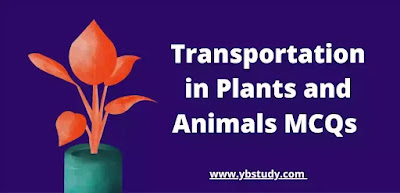MCQ on Transportation in Plants and Animals Class 10
MCQs on Transportation in Plants :
We brings Here MCQ Questions and Answers on Transportation in Plants and Animals. which is very important in exam point of view. With every questions test your knowledge. Multiple Choice Questions on Transportation in Plants and Animals are available for free, you can test your knowledge anytime and share the links with your friends to help them check their knowledge.
Important points to Remember about Transportation in plants and Animals Class 10 :
- Transportation is a vital process in plants and Animals. Trees transport all the water and nutrients from roots to the other parts of plants for survival from its roots to the tips of the leaves.
- For the verious metabolic process of plants like photosynthesis, transpiration, guttation raw materials should be transported from root to the leaves.
- For transport in plants, they need a transport system to move food, water, and minerals around because for them no heart, no blood, and since these plants do not have a circulatory system, transportation makes up for it. Plants have tissues to transport water, nutrients and minerals.
- Plants have two transport systems – xylem and phloem.
- Generally Xylem tissue transports water and mineral salts from the roots to the other parts of the plant,
- while phloem tissues transports Carbohydrates, sucrose and amino acids from roots to the leaves and other parts of the plant.
- Transport of verious nutrient materials is necessary in both plants and animals as every cell needs a regular supply of nutrients and oxygen for production of energy through verious metabolic reactions.
- Transportation in animals is defined as movement of Nutrients, water and oxygen to different parts of the body by use a system like circulatory system and excretory system.
- Blood flows in the blood vessels and transports the Nutrients or digested food from the small intestine to every parts of the body. There are mainly two types of blood vessels veins and arteries.
MCQ Questions on Transportation in Plants and Animals Class 10 Pdf :
1. If a plant kept in light with a high internal CO2, content transferred to dark CO2, free environment then stomata will__________
(a) First close and then open
(b) Remain closed
(c) Remain open
(d) Open first and then close
Answer: D
2. Which of the following is fully permeable, but does not show imbibition___________
(a) Cellulosic cell wall
(b) Biological membrane
(c) Lignified cell wall
(d) Suberised cell wall
Answer: C
Read : MCQs on Photosynthesis
3. Which of the following may be helpful in phenomenon of night recovery in plants ?
(a) Capillary water
(b) Hygroscopic water
(c) Chemically combined water
(d) Water vapours
Answer: D
4. Find the incorrect statement in relation to passive absorption of water___________
(a) Roots are not essential
(b) Creates a negative pressure in xylem sap
(c) It is symplastic
(d) It is dependent on transpiration
Answer: B
5. Amount of water transpired per unit of dry matter produced during growing seasons of a plant is called________
(a) Transpiration flux
(b) Transpiration index
(c)Stomatal index
(d) Transpiration ratio
Answer: B
6. Rate of guttation decreases in_________
(a) Well watered soil
(b) Soil with good aeration
(c) High DPD of atmospheric air
(d) High atmospheric pressure
Answer: C
7. Which one of the following is a correct statement?
(a) Minerals and water are absorbed simultaneously.
(b) Water is mainly absorbed against the
concentration gradient.
(c) Absorption of water and minerals takes place independently.
(d) Mineral are absorbed along the ions
Answer: C
8. The action spectrum of transpiration is__________
(a) Blue & red
(b) Blue & far-red
(c) reen & red
(d) Green & far-red
Answer: A
9. Transpiration is significant in________
(a) Development ol mechanical tissue,
(b) Increasing quality of tissue
(c) Decreasing concentration of minerals
(d) Both (a) & (b)
Answer: D
10. Transpiration magnitude is higher in smaller plants then larger plants due to__________
(a) More stomatal frequency
(b) More transpiration index
(c) High root/shoot ratio
(d) Low root/shoot ratio
Answer: C
11. Which among the following is not an objection to the Munch’s pressure flow hypothesis_________
(a) Vacuoles of adjacent sieve tube cells are not continuous.
(b) Rate of flow of water and solutes can be different in the same sieve tube
(c) Phloem transport is not influenced by water deficit.
(d) Injury in the plants cause exudation of solution rich in organic solutes.
Answer: D
12. Food is translocated in phloem as_______
(a) Raffinose
(b) Sorbitol
(c) Sucrose
(d) All of these
Answer: C
13. Sugar translocation in sieve tubes is a___________
(a) Physiological process
(b) Bidirectional process
(c) Physical process
(d) Both (a) & (b)
Answer: D
14. The pressure bomb technique is used for measuring________
(a) Root pressure
(b) Tension on water column
(c) Transport velocity of xylem sap
(d) Imbibition pressure
Answer: D
15. When plant shows wilting of leaves at noon and recovery at evening, it is_________
(a) Incipient wilting
(b) Permanent wilting
(c) Mid-day desiccation
(d) Temporary wilting
Answer: D
16. The correlation between the number of stomata and the epidermal cells per unit area is called________
(a) Stomatal index
(b) Stomatal frequency
(c) Transpiration coefficient
(d) Both (a) & (b)
Answer: A
We hope the above given MCQ on Transportation in Plants and Animals with Answers Pdf Download will help you to score high in your board exam as well as various competitive entrance examinations also. If you have any queries regarding Transportation in Plants and Animals Multiple Choice Questions with Answers, drop a comment below.

